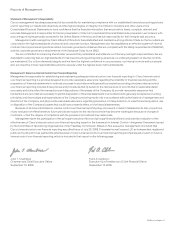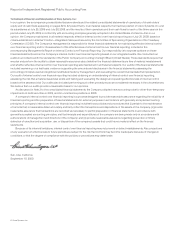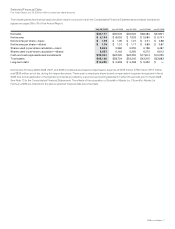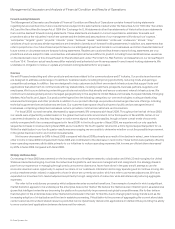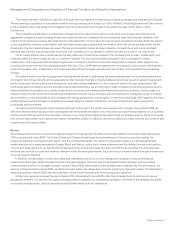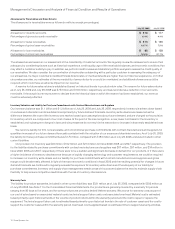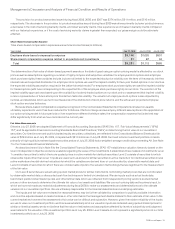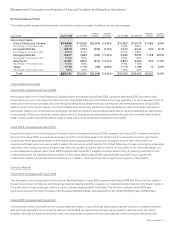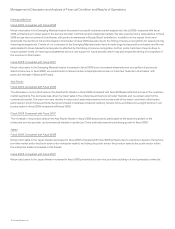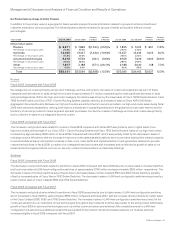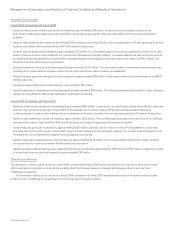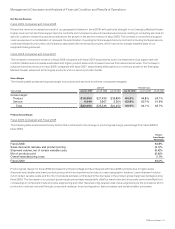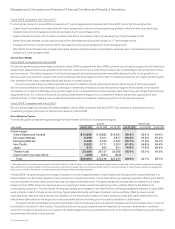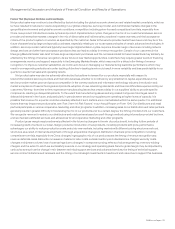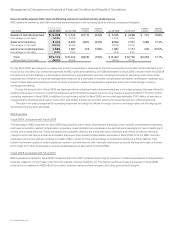Cisco 2009 Annual Report Download - page 16
Download and view the complete annual report
Please find page 16 of the 2009 Cisco annual report below. You can navigate through the pages in the report by either clicking on the pages listed below, or by using the keyword search tool below to find specific information within the annual report.
Management’s Discussion and Analysis of Financial Condition and Results of Operations
Other-Than-Temporary Impairments We recognize an impairment charge when the declines in the fair values of our fixed income or
publicly traded equity securities below their cost basis are judged to be other than temporary. The ultimate value realized on these
securities, to the extent unhedged, is subject to market price volatility until they are sold.
Effective at the beginning of the fourth quarter of fiscal 2009, we were required to evaluate our fixed income securities for impairments
in connection with the recognition provisions of Financial Accounting Standards Board (“FASB”) Staff Position FAS 115-2 and FAS 124-2,
“Recognition and Presentation of Other-Than-Temporary Impairments” (“FSP 115-2”). If the fair value of a debt security is less than its
amortized cost, we assess whether the impairment is other than temporary. Under FSP 115-2, an impairment is considered other than
temporary if (i) we have the intent to sell the security, (ii) it is more likely than not that we will be required to sell the security before recovery
of its entire amortized cost basis, or (iii) we do not expect to recover the entire amortized cost of the security. If an impairment is considered
other than temporary based on (i) or (ii) described above, the entire difference between the amortized cost and the fair value of the security
is recognized in earnings. If an impairment is considered other than temporary based on condition (iii), the amount representing credit
losses, defined as the difference between the present value of the cash flows expected to be collected and the amortized cost basis of the
debt security, will be recognized in earnings and the amount relating to all other factors will be recognized in other comprehensive income
(OCI). In estimating the amount and timing of cash flows expected to be collected, we consider all available information including past
events, current conditions, the remaining payment terms of the security, the financial condition of the issuer, expected defaults, and the
value of underlying collateral. We did not have any impairment charges on fixed income securities subsequent to the adoption of FSP
115-2. Prior to the adoption of FSP 115-2, we recognized impairment charges on fixed income securities using the impairment policy as is
currently applied to publicly traded equity securities, as discussed below.
For publicly traded equity securities, we consider various factors in determining whether we should recognize an impairment charge,
including the length of time and extent to which the fair value has been less than our cost basis, the financial condition and near-term
prospects of the issuer, and our intent and ability to hold the investment for a period of time sufficient to allow for any anticipated recovery
in market value.
The total impairment charges that were recognized in earnings on investments in fixed income securities and publicly traded equity
securities were $258 million for fiscal 2009. There were no such impairments in either fiscal 2008 or fiscal 2007. Our ongoing consideration
of all the factors described above could result in additional impairment charges in the future, which could adversely affect our net income.
We also have investments in privately held companies, some of which are in the startup or development stages. As of July 25, 2009,
our investments in privately held companies were $709 million, compared with $706 million as of July 26, 2008, and were included in other
assets. See Note 5 to the Consolidated Financial Statements. We monitor these investments for events or circumstances indicative of
potential impairment and will make appropriate reductions in carrying values if we determine that an impairment charge is required, based
primarily on the financial condition and near-term prospects of these companies. These investments are inherently risky because the
markets for the technologies or products these companies are developing are typically in the early stages and may never materialize. Our
impairment charges on investments in privately held companies were $85 million, $12 million, and $22 million in fiscal 2009, 2008, and
2007, respectively.
Goodwill Impairments
Our methodology for allocating the purchase price relating to purchase acquisitions is determined through established valuation
techniques. Goodwill is measured as the excess of the cost of acquisition over the sum of the amounts assigned to tangible and identifiable
intangible assets acquired less liabilities assumed. We perform goodwill impairment tests on an annual basis in the fourth fiscal quarter and
between annual tests in certain circumstances for each reporting unit. The goodwill recorded in the Consolidated Balance Sheets as of
July 25, 2009 and July 26, 2008 was $12.9 billion and $12.4 billion, respectively. In response to changes in industry and market conditions,
we could be required to strategically realign our resources and consider restructuring, disposing of, or otherwise exiting businesses, which
could result in an impairment of goodwill. There was no impairment of goodwill in fiscal 2009, 2008, or 2007. We performed a sensitivity
analysis for goodwill impairment with respect to each of our respective reporting units and determined that a hypothetical 10% decline in
the fair value of each reporting unit as of July 25, 2009 would not result in an impairment of goodwill for any reporting unit.
Income Taxes
We are subject to income taxes in the United States and numerous foreign jurisdictions. Our effective tax rates differ from the statutory rate
primarily due to the tax impact of state taxes, foreign operations, research and development (R&D) tax credits, tax audit settlements,
nondeductible compensation, international realignments, and transfer pricing adjustments. Our effective tax rate was 20.3%, 21.5%, and
22.5% in fiscal 2009, 2008, and 2007, respectively.
14 Cisco Systems, Inc.



